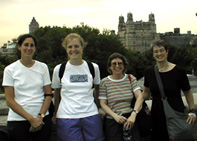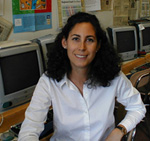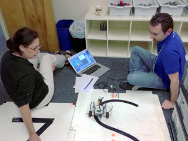Logo Foundation Staff
Hope Chafiian
BA in Economics and Psychology, Emory University, 1986
MA in Teaching and Curriculum, Teachers College, Columbia
University, 1988
 |
 |
 |
 |
A college course in Child Development introduced me to Piaget’s constructivist theory that describes how learning happens: People are creators of their own knowledge via interactions with other people and the physical world around them. I learned about the cognitive stages that all children pass through, and how that process affects their understanding of the world. While taking this course, I had a part-time job as an assistant teacher in a classroom for four year olds. I used the classroom as my own laboratory to test out Piaget’s ideas and replicated some of his famous experiments interviewing children. I asked the four year olds “What makes the wind?” and “Which glass has more water?” trying to determine whether they had reached certain stages of development. My experiments were successful; I got the same results as Piaget. This experience laid the foundation and helped shape my thinking about learning and teaching.
Entering the workforce in 1986, I had a strong desire to be a modern-day working woman, one who reaped the benefits of gender equality that the women’s movement achieved up to that point. The least appealing jobs were ones that required good typing skills (I purposefully did not learn how to type in high school) or traditional women’s work, like teaching. It’s ironic how life turned out for me.
I took an entry-level job at a Japanese bank in New York City and felt I was embarking on a promising career in finance. However, after the first week of work, with hours spent reconciling differences of pennies between loans, I realized I was in the wrong career. I needed to do something more meaningful, so I applied to graduate school in education.
In graduate school I found many connections between John Dewey’s writings about experiential education and Piaget. While finishing my masters program, I interviewed for a computer job at The Spence School. During the interview, I was asked to describe the link between Piaget and computers. I had no idea, but became curious to find out. After accepting the position I took an introductory course in Logo at Bank Street College of Education and fell in love with the language. Learning Logo was transformational. The ‘aha’ moments occurred frequently as I explored this new world, and I felt myself constructing a new, deeper understanding of geometry, appreciating the power of this learning environment. I was constructing knowledge out of this new experience, just as Piaget described how learning happens. In reading Mindstorms, I realized that Papert is the link between Piaget and computers. The Logo environment provides specialized tools that enhance mathematical learning and guides learners to gain understanding through their own explorations. I was hooked and knew that I had found the right career.
My connection to the Logo Foundation, first as a workshop participant, then as a workshop facilitator, expanded my world as a teacher. I felt like I was on the cutting edge, having the chance to test different versions of LCSI’s software including Logo Ensemble and MicroWorlds. In the 1990’s I presented my work at various conferences including NECC, NYSAIS, Logosium, Mindfest, BAKE (Boston Association of Kodaly Educators) and OAKE (Organization of American Kodaly Educators). During that time I also served as Secretary Treasurer of SigLogo, the Logo special interest group of ISTE.
Logo has been a bridge to a land of opportunities. I became interested in robotics when text versions of Logo were able to communicate with the early robotic systems. When LogoBlocks arrived on the scene in the late 1990s, this blocks-based logo environment was a game changer for robotics, making concepts of variables and conditionals statements accessible to elementary school students. When Scratch was introduced in 2006 it was a pivotal moment for educational computing. Scratch has had a major impact on learning computer science, more than any other computer language introduced recently. Its user-friendly environment removes the obstacles of syntax errors and presents all the code up font. This has opened the door to younger programmers and more types of learners, while also containing most Logo commands that support more complex programming.
Over the years I worked with many different robotics kits including Control Lab, RCX, Handy Cricket, Pico Cricket, Scratch Pico board, NXT, EV3, Lilypad, Hummingbird, and Finch. I taught myself other computer languages including Real Basic, Python, Processing and Arduino, and I attribute my ability to do so to my understanding of Logo.
Since 1988, I have been teaching Logo programming to kindergartners through high school students. The software has changed over the years, but the teaching goals have remained constant. In my classes, I strive to engage students in a process where they explore, design and build something important and meaningful to them. They learn by doing. They make mistakes and they fail. They develop strategies for problem solving and they find solutions. They collaborate with their classmates, they help discover errors and help each other debug.
In recent years, we have seen a blending of "coding" and "making" in the curriculum, lifted up by STEM Education. The "Maker Movement" is becoming part of mainstream school, with its activities and cultures carrying many of the same ideas that come from Dewey, Piaget and Papert. For those in the Logo community who have been enmeshed in constructionist education for a long time, we are thrilled that there are many Scratch-like environments that interact with the physical and 3D worlds, which seamlessly bring together coding and making.